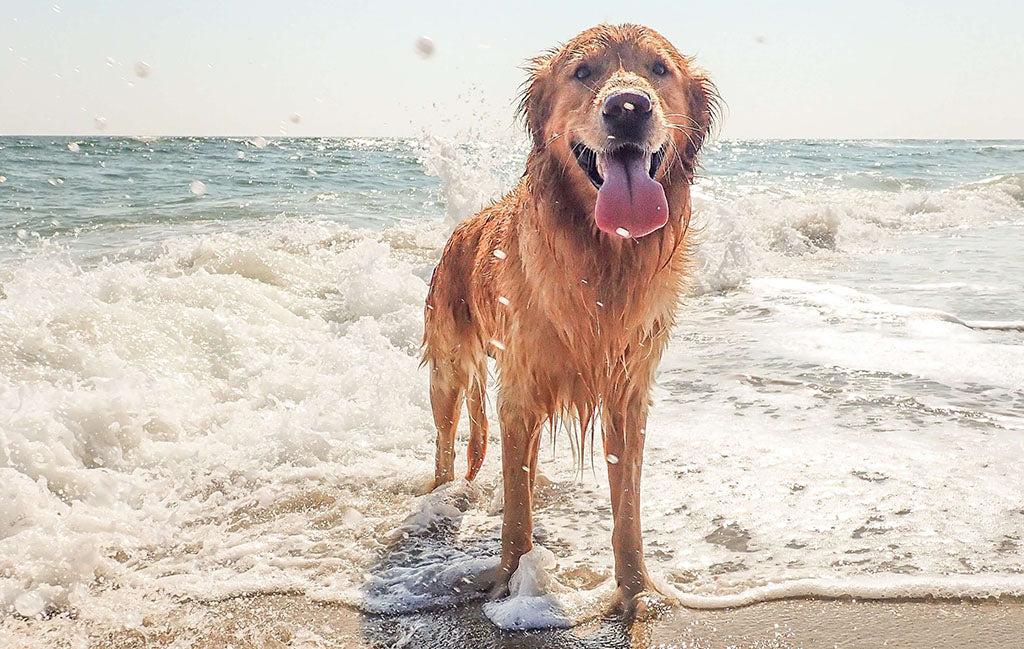Taking your pup to the beach can be a joyful experience, but it also comes with unique challenges. From paw protection to preventing dehydration and recognizing signs of discomfort, here’s our advice on how to look after dogs at the beach.
- Home/
- Dog/
- Health & Wellness/
- Looking After Dogs at the Beach: Hydration, Heat Awareness & Aftercare
Looking After Dogs at the Beach: Hydration, Heat Awareness & Aftercare

Quick takeaway: To look after your dog at the beach, avoid visiting during the hottest hours of the day and ensure your dog has access to adequate shade and fresh drinking water. Never let your dog eat seaweed from the beach as it is not suitable for dogs to eat, and keep a close eye on their behavior to spot any signs of discomfort, such as sore paws or saltwater irritation if they are swimming in the sea.
What Should I Know Before Taking My Dog to the Beach for the First Time?
Running through sand and splashing in the sea with your dog can be super fun, but how do you make sure they stay happy, healthy and safe? In this article, we cover looking after dogs at the beach – what to bring, how to prepare, and which signs of occasional discomfort to look out for after your pup enjoys a day of seaside fun and play.
There are a few key risk factors and important considerations every responsible pup owner needs to know before taking their dog to the beach for the first time. Digging in sand, dipping their paws in the sea and enjoying the ocean breeze can be a wonderful experience for your furry best friend, but it’s important to take the proper precautions before exposing them to elemental allergens, high heat and salty water.
Table of Contents: Looking After Dogs at the Beach
- Can Dogs Go to the Beach?
- Do Dogs Like the Beach?
- Can Being at the Beach Cause Dog Skin Discomfort?
- How Do I Avoid My Dog Overheating at the Beach?
- Can Dogs Eat Seaweed off the Sand?
- Should I Let My Dog Swim in the Sea?
- What Should I Know About Dog Paws on Hot Sand?
- How Can I Keep My Dog Cool and Hydrated at the Beach?
- Beach Day Essentials for Dogs
- Does My Dog Need a Bath After Being in the Sea?
- How Do I Get Sand Out of My Dog’s Fur?
Can Dogs Go to the Beach?

Yes, many dogs can go to the beach, and lots of pups absolutely love it. But not all dogs enjoy the sights, sounds, and sensations of coastal environments. If your dog is sensitive to noise or heat, a quieter cove with shade may be a better option. It’s essential to check beach regulations beforehand, as not all beaches allow dogs, and some may allow your pup to accompany you but require that they stay on a lead. Always bring essentials like fresh water, poop bags, healthy treats and a sunshade or umbrella for your pup.
Do Dogs Like the Beach?
Some dogs thrive at the beach, chasing waves, digging in the sand, and cooling off in the sea. Others may find it overwhelming. Watch your dog’s body language: tail wagging, a relaxed gait, and curiosity are good signs. Stress signals like panting, pacing, or trying to hide might indicate your dog prefers a different environment.
To Help Your Pup Enjoy the Beach More:
- Introduce them gradually – spend a little time walking together along the sand, with your dog on leash, and slowly spend more time enjoying the beach with your furry friend.
- Stay close and reassuring – keep a close eye on your pup’s behavior and how they are responding to other people and dogs at the beach. If your dog seems anxious, or gets uncomfortable with the heat, noise, sand or sea, make sure not to prolong the trip.
- Avoid peak heat hours – the beach environment is prone to extreme temperatures due to the lack of shade and the way that sand naturally heats up and stays warm – too warm for your pet’s paws at the hottest part of a summer day!
- Bring their favorite toys – this is comforting and reassuring for your pup, and gives them a fun distraction while you’re enjoying the sand and sea.

Can Being at the Beach Set off My Dog’s Environmental Allergies?
Yes, being at the beach can trigger your dog’s environmental allergies, especially if they’re sensitive to factors like pollen, salt, sand, or seaweed. Just like humans, dogs can experience occasional itching, scratching and general irritation if they are exposed to airborne or skin irritants. Signs of environmental allergies can include:
- Occasional itching or licking
- Watery eyes or sneezing
- Irritated skin
- Scratching at ears, or head shaking
Saltwater and wind-blown sand can dry out your pup’s skin or trap irritants in their fur. Dirty seaweed can cause your pup to become ill – it’s best to keep a close eye on your pup and ensure that they don’t eat seaweed at the beach.
How to Help Your Dog Manage Beach-Triggered Environmental Allergies
To support your dog’s environmental allergy response, consider daily supplementation with PetLab Co.’s Probiotic Chews. These functional soft chews are specially formulated to help your pup maintain healthy gut flora and support the immune system. Consistent daily use can lead to a better response against seasonal and environmental allergy discomfort.
Pro tip: Rinse your dog thoroughly after beach play to remove salt, sand, and allergens from your dog’s coat. Then, monitor for any signs of irritation over the next 24 hours.
How Do I Help My Dog Avoid Overheating at the Beach?
To avoid your dog overheating, make sure that you prepare properly before leaving for your trip, keep a close eye on your dog at the beach, and respond quickly to any signs of distress in your dog after the trip. Dogs that have been exposed to sun, heat, moisture, and sand for extended periods need keeping a close eye on when the fun is over, especially if they’ve been running around and getting wet.
Tips To Prevent Overheating in Dogs at the Beach:
Overheating is a medical emergency. Dogs can overheat very quickly, particularly brachycephalic breeds (like Bulldogs or Pugs), puppies, seniors, or dogs with thick coats.
To keep your dog safe from overheating:
- Visit the beach during cooler hours (early morning or late afternoon)
- Bring a sunshade or umbrella so your dog can rest in the shade
- Provide cool, fresh water at all times using a travel-friendly option like the PetLab Co. Multi-Functional Water Bottle
- Limit intense activity like fetching or swimming in peak heat
- Watch for warning signs, such as heavy panting, drooling, vomiting, confusion, or collapse. If you notice any, move your dog to shade immediately, offer water, and contact a vet.
Beach days are meant to be fun, and with a few smart precautions, you can keep your pup comfortably enjoying the sun and sea.
Can Dogs Eat Seaweed off the Sand?
This is a common question from pet parents, and the answer is: not safely. While dogs can eat certain types of seaweed, like nori (used in sushi), which is safe in small amounts, beach seaweed can be contaminated with pollutants or sharp shells. Therefore, beach seaweed is not safe for dogs to eat.
Natural seaweed, free of salt and additives, can be a source of minerals and fibre. However, beach-found seaweed can be dangerous if ingested due to potential contaminants. Dried seaweed can expand in the gut, too.
Instead of letting your dog snack on seaweed at the beach, bring healthy treats to keep them happy and full while they’re enjoying their doggy beach day.
Should I Let My Dog Swim in the Sea?

Swimming can be great exercise for dogs, but it’s really important that you supervise them carefully whenever they are in the water. Saltwater can irritate your dog’s eyes, nose, and skin, and ingesting too much can lead to salt poisoning.
When letting your dog swim at the beach:
- Check currents and tides before heading out
- Have a dog life jacket available for use if needed
- Be ready to rinse your dog with fresh water straight away after their swim to avoid irritation of their skin from the sea water
What Should I Know About Dog Paws on Hot Sand?
Hot sand can burn your dog’s paws. To test the sand’s temperature, place your hand on it for 10 seconds. If it’s too hot for you, it’s too hot for your pup’s sensitive paws.
Tips when walking your dog on the sand:
- Visit the beach early in the morning or late in the afternoon
- Use paw wax or booties if needed
- Encourage breaks on a towel or shaded mat
If in doubt, avoid direct sand contact during peak sun hours.
How Can I Keep My Dog Cool and Hydrated at the Beach?
When taking your dog to the beach on a hot day or pursuing any outdoor activity during warmer weather, hydration is crucial. Dehydration and overheating can occur quickly, especially in active dogs. Bring a multi-functional bottle, such as the PetLab Co. Water Bottle, which features a drinking tray, filter, and leak-proof design.
Other cooling tips:
- Provide a shady retreat (umbrella or portable sun tent)
- Take frequent breaks
- Use a cooling vest or a damp towel
- Avoid midday sun
Watch for signs of overheating: excessive panting, drooling, or lethargy. If your dog shows these signs, move them to the shade, offer water, and cool them with a damp cloth.
Beach Day Essentials for Dogs
| Product | Purpose | Key Features |
| PetLab Co. Water Bottle | Hydration on the go | Built-in tray, leak-proof, filters water |
| PetLab Co. Probiotic Chews | Helps with occasional allergy discomfort | Gut health, seasonal allergy support |
| Dog Paw Wax or Booties | Cover paws when on hot sand | Heat-resistant, moisture barrier |
| Portable Dog Sun Tent or Umbrella | Provide shade | Easy setup, UV-blocking fabric |
| Cooling Vest or Mat | Help regulate temperature | Keeps your dog cool via evaporation |
Does My Dog Need a Bath After Being in the Sea?
Yes, your dog should always get a bath or at least a thorough rinse after being in the sea. Saltwater, sand, and microorganisms can cling to their fur and skin, leading to dryness, irritation, or even infection if left unaddressed.
Why a Post-Beach Bath Matters:
- Removes salt and sand: Salt can dry out your dog’s skin, and sand can cause friction, leading to itching or discomfort.
- Reduces the risk of skin irritation: Ensure your dog’s skin is salt, sand and irritant-free to avoid itching or dryness.
- Washes off bacteria or irritants: Decaying seaweed and stagnant seawater can contain microbes that trigger occasional allergy discomfort
Bathing Tips After the Beach:
- Use lukewarm water to rinse thoroughly, even if you’re not using shampoo every time.
- Choose a gentle, dog-specific shampoo if giving a full bath. Avoid human products that can strip oils.
- Towel-dry carefully, especially between toes, ears, and skin folds.
- Monitor for signs of occasional skin discomfort, such as licking or scratching in the following days.
For added support, especially during the summer, consider PetLab Co.’s Probiotic Chews. They help support your dog’s immune system and skin barrier
Additional Resources
- American Kennel Club: Beach Safety for Dogs
- VCA Animal Hospitals: Summer Safety Tips for Pets
- Cornell University: Canine Heatstroke Awareness
Conclusion: Should You Take Your Dog To The Beach?
Taking your dog to the beach is a rewarding way to enjoy nature together, but it does require planning. Keep your pup cool, hydrated, and supported. Avoid unsafe snacking on beach seaweed, and make sure to take along the right gear, such as healthy treats and a convenient water bottle. Happy splashing!
Glossary of Terms
- Occasional allergy discomfort – dogs with seasonal or environmental allergies may experience occasional itching, scratching and general irritation
- Overheating – a life-threatening condition where the dog’s body temperature rises dangerously high and the dog is unable to reduce its body temperature by panting
- Salt Poisoning – A condition caused by ingesting too much saltwater, leading to discomfort, or more severe issues.
 C
C



